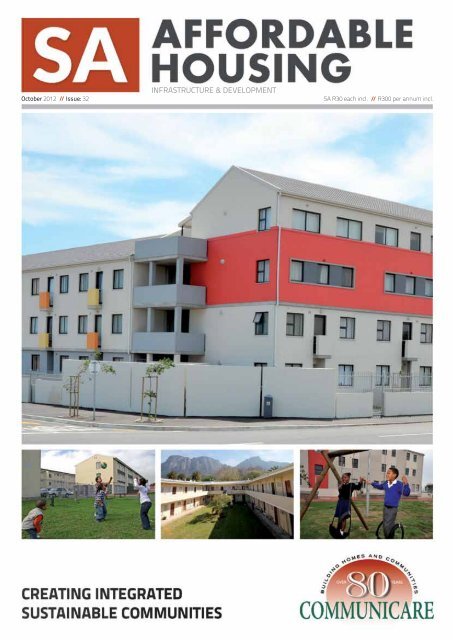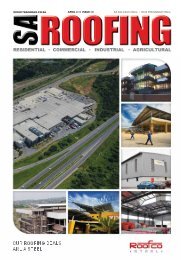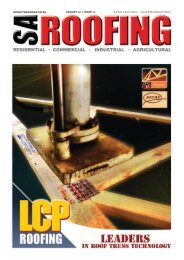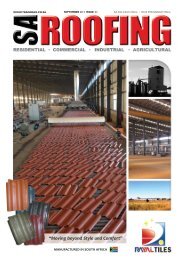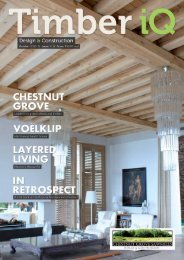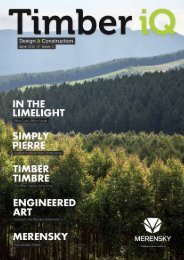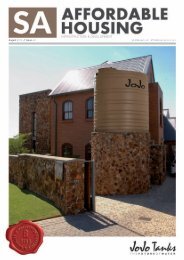October 2012 - Trademax Publications
October 2012 - Trademax Publications
October 2012 - Trademax Publications
You also want an ePaper? Increase the reach of your titles
YUMPU automatically turns print PDFs into web optimized ePapers that Google loves.
We design & manufactureall precision roof trussesAt our Builders truss divisionwe offer the following services:• Free roof truss quotations• Professional advice and friendly service• Supplier of all roof coverings at competitive prices• Member of the ITC (Institute for Timber Construction)• ITC certificate offered with all quotes(Roof inspection A19 certificate)• Precision truss manufacturing• Installation of trusses and coverings• 5-7 day turn-around from order to delivery** (order means that money has been deposited and reflects in the Builders account)TWNA19_Week 6_<strong>2012</strong>_XFOR YOUR NEAREST STORE CALL OUR CALL CENTRE0860 builders/0860 284 533or visit us at www.builders.co.zalike follow share check
ed’s noteWhat is workingThe last quarter of the year at the SA Affordable Housingmagazine is a conspicuous one in that it is highlighted withnumerous conferences, industry events and award ceremonies.In September, the Southern African HousingFoundation’s International Housing & ConstructionConference provided a platform for industry players tocome together and discuss how South Africa can buildcapacity for sustainable housing delivery.When we talk about how to fix or improve things, weinevitably discuss what needs fixing. The conversationaround the state of housing in South Africa highlightedissues around education, access to basic services and, veryimportantly, sanitation, which are all directly linked tohealth, future-building and basic human dignity.When we talk about how to fix or improve things, it is alsoimperative that we celebrate successes and rewardforethought, initiative and excellence. The many awardstaking place at this time of year have highlighted thatbuilding homes is not about endlessly supplying shells forpeople to live in.Building communities is about aiding the development ofpeople and their quality of life; it’s about individuals,families and communities having the agency to script theirown lives, living productively, proactively and with hope.Although we should never lose sight of the sad reality ofsanitation as it is, shoddily built homes and poorsupporting infrastructure, it is heartening to see deservingorganisations and partnerships win prestigious awardsthat highlight what they are doing right to make housingand its supporting infrastructure work.With that, I welcome you to the <strong>October</strong> issue of the SAAffordable Housing magazine, where we, too, take the timeto proudly showcase what is working.Enjoy the read!Jen2OCTOBER <strong>2012</strong>
NEWSRewarding excellenceDespite inadequate infrastructure and a lack of basic resources, Vele Secondary School,in the northern Vhembe District of the Limpopo Province, excelled academically.In partnership with the Limpopo Department of Education, the Creating Schoolsprogramme and East Coast Architects designed and built a new school.Words: Steve Kinsler & Derek van Heerden - East Coast ArchitectsPhotographs: Courtesy of East Coast Architects, AfriSam-SAIA and Angela BucklandSchools play a critical role in the life ofcommunities, especially those situated in remoteand forgotten areas. These areas are typicallyunder-served by other public or privateinstitutions and, consequently, offer few opportunities forsocial, cultural, or economic growth.The full potential of schools can only be realized throughinnovative partnerships that extend beyond the rolestraditionally established between government andsociety, or between donors and recipients. Instead, a newapproach must be shaped; one that builds on the skills,resources and commitment of a range of partnersincluding governmental and NGO stakeholders, the privatesector and local communities. In that spirit, the CreatingSchools programme in partnership with East CoastArchitects provided an opportunity to lead the way bydrawing on the success of their collaboration on the SevenFountains School project and developing new partnershipsto replicate that programme with the Vele SecondarySchool.The design team first engaged with the school communityearly in 2008. A number of initiatives were pursued, whichincluded free-ranging discussions with teachers andlearners, as well as more structured conversations withlocal traditional leaders – this was made more interestingbecause Vele Secondary school is located almostequidistant from four surrounding villages and acceptslearners from primary schools located in those villages.Another immediate initiative was the installation of adigital weather station at the school – the nearest formalweather station some 50km distant and 1000m variant inaltitude was considered unreliable for the micro climaticdata we were seeking to inform effective passive solardesign and rainwater harvesting strategies.4OCTOBER <strong>2012</strong>
newsThe primary goal of the Creating Schools programme is todevelop schools as community hubs and centres oflifelong learning. Through carefully considered siteplanning the school is designed to accommodatecommunity use, whilst at the same time respecting theoperational requirements of the school. Sharedcommunity facilities, such as the sports fields, hall andeducational resource centre are sited adjacent to the mainroad, whilst the classrooms and learner courtyards aredeeper into the site.The administration centre with a first floor staff room andveranda are located centrally and at the highest point ofthe site thereby providing surveillance views into theentire school. Through an innovative funding model theCreating Schools programme enters into partnerships withprovincial departments of education. Further partnershipswith local communities ensure sustainable managementand use of the school. Energy efficient design and waterconservation strategies reduce the running costs of theschool.The classroom layouts allow for flexibility and respond tothe needs of the educational curriculum.Detailing and finishes are robust yet user friendly.Particular emphasis is placed on design, construction andoperational activities that maximise the skillsenhancement and social development of the participants.The school facilities and infrastructure provide learningopportunities in life skills, such as food production, energyefficient building, renewable energy systems and waterharvesting.Robust materials and detailing reduce the maintenancecosts. The school meets the EducationDepartment’s Norms & Standards and to ensurereplicability of the model, it is built within the budgetallocated to a typical Limpopo DoE school using standarddocumentation. Each school in the programmeparticipates in a comprehensive post-occupancymonitoring and evaluation process.Close collaboration between the architects and passivelow energy engineers led to the innovative design oflearning spaces that optimise the comfort levels of thelearners and teachers.OCTOBER <strong>2012</strong> 5
NEWSInclusionary processes employed at VeleSecondary School:Passive Low Energy Design (PLED)techniques include:• Gather accurate climate data through the early installation of adigital weather station on site• Optimal solar orientation of all occupied spaces• Appropriate insulation built into floors, walls and roofs• Natural ventilation techniques for summer and winter• Natural lighting with particular emphasis on light shelves, rooflights and window placementRenewable Energy SystemAn Eskom donation financed the installation of a 50m² solarphotovoltaic array, which provides electricity for the ITinfrastructure and the borehole water pumping at the school. Itwas made clear from the outset that renewable energy sources arenot free and that the inverters, batteries and panels requireregular maintenance and periodic replacement. The valuablephotovoltaic panels are securely fixed onto a north-facing, secondfloor roof and for security reasons are not visible from the road.Energy Monitoring“You can’t control what you can’t measure.” Tom De MarcoAn energy monitoring system has been installed to createawareness about energy consumption and to help the schoolreduce electrical energy costs.The system works by:• Informing when and where electricity is used. The school canthen control and conserve electricity use.• Showing how much this electricity costs the school in real randterms, carbon footprint and in comparison to previous months.• Educating learners about the importance of saving electricity.6OCTOBER <strong>2012</strong>
NEWSGreen RoofsThe science laboratories, administration centre, ablutionsand covered walkways all have green roofs to both preservebiodiversity and to impart other qualities, such as goodinsulation, aesthetics and assist in the management of stormwater runoff. All green roof planting uses hardy, droughtresistant, indigenous plants from the region, requiring nowatering and little maintenance.Vele Secondary School recently won theAfrisam-SAIA Award for SustainableArchitecture, alongside Lebone II Collegein North West, under the category forbuilt work that has been beneficiallyoccupied from 15 March 2011.Stone construction for walling, facing and paving was usedextensively and local masons were engaged – most weregraduates of the school. Stone was collected from roadverges and from areas being cleared for agriculture, therebyreducing the reliance on imported brick and/or cement-basedmaterials for these areas. The contractor twinnedexperienced masons with younger workers who hadexpressed interest, thus ensuring continuity of this beautifulcraft. Masons were encouraged to express their ‘signature’patterning, rather than slavishly aim for uniformity.The slender, taller cylindrical building forms, with steeperpitched roofs (as compared with the squatter, lower pitchedrondavels of native KZN) together with the skirted ‘sunbench’ plinth (the sitting person either tracks the sun inwinter or the shade in summer) was explored in the tall stonelibrary tower and the lower children’s library drum. The sunbench in the former is an internal bench with signature whitepebble banding reducing the internal scale.Other important informants were the importance of danceand music as performance, manifesting in a tieredamphitheatre space with rammed earth dance-floor (concreteor stone was considered too hard for barefooted dancers), aswell as the beautiful colouring of the dance costumes, whichinformed the palette of colours, especially the lime greenused to accent metalwork and door and window frames.8OCTOBER <strong>2012</strong>
89%71%83%
green buildingCorobrik proud to be part of the firstfully constructed municipal building toachieve 4 Green Star ratingThe City of Cape Town Human Settlement Contact Office in Manenberg hasrecently been awarded a 4 Star Green Star SA rating and is the first fullyconstructed local municipal building in South Africa to achieve a rating.Photographs by Bruce SutherlandThe front view of the City of Cape Town Human Settlements Contact office showing mosaicwork on concrete and Corobrik’s De Hoop red satin face brick.The building, designed by Ashley Hemraj withGoodhope Construction as the main contractors, issituated on Landsdowne Road in Manenberg and isused by the local community as a space to makeenquiries regarding the housing database, paying theirmunicipal accounts, traffic fines, etc. It was completed inApril <strong>2012</strong>, with the Green Star rating granted in earlyAugust.When embarking on the project, Hemraj had no guidelinesregarding what was required in order to obtain a GreenStar rating for a municipal building and had to useinformation available from other sources. However, thefinal results are a demonstration of Cape Town’s localmunicipality’s commitment to sustainable developmentand its green goals.Hemraj notes that, whilst being environmentallyresponsible, the selection of the site, the position of thebuilding and the involvement of the local community wereof great importance. The local community were involved inthe mosaic work throughout the building.Members of the community worked with a lead artist toproduce the images, while the hanging artwork adorningthe public hall space was sourced from a local artist. Froma construction point of view, local workers were employedto construct some of the walls using sandbags. “Wetrained them on site in the sandbag technology, whichinvolved filling, laying and then plastering the bags, aswell as the assembly of the ‘Eco Beams’,” explains Hemraj,adding that, “Using the local community has resulted in20% of the labour on site being local when normally it isless than 10%.”Other artworks around the building were ‘Graffiti’ worksfrom the community. We involved “Falko” a self-taughtCape Town-based artist who is doing his best to get theyouth off the street and involved in art that could inspireand change lives. Born in Mitchells Plain and schooled inWestridge Senior, we involved him in our project as a SmallEnterprise. He then engaged three schools, of which hetrained 10 grade 5 and 6 pupils in the art form, whilstcreating the public artwork on the Manenberg project. “Iam doing my best to make street art viable for up-comingnew talent.”12OCTOBER <strong>2012</strong>
green building“A 4 Green Star building breaks even on cost/investment, withsignificant long-term benefits,” says Hemraj. “We predict thatwe are saving an estimated R44 000-R48 000 per year inelectricity at the City of Cape Town Housing Contact Office.That means that at today’s electricity costs we will have apayback for the renewable energy component in just 4-5 years.Further to the solar power, a wind turbine supplementselectricity on cloudy or rainy days. The electricity is stored inbatteries and can run the building for an estimated three days.”Hemraj believes that it’s not just all about the constructionmaterials. “The social and economic elements are starting tobecome an important element of green buildings. We didn’t getany points for our primary objective to include unskilled locallabour. Although the training process did slow the project downslightly, we are very proud of this building,” he explains.Hemraj does, however, stress that using labour intensivemethods of construction should be implemented from as earlyas the conceptual design stage.The internal courtyard showing the mosaic work onconcrete and Corobrik’s De Hoop Satin Face brick.Due to security concerns the client had wanted the wholebuilding to be fenced off amid fears of damage and vandalism.“We demonstrated, however, that the social connection is animportant one and that one should open spaces up to the localcommunity.”“We want the community to be proud of where they live, so thatthey feel comfortable to reinvest within and remain committedin fighting for a better community environment. We wantedthis building to be an inspiration in Manenberg, something thatwe, the City and the community, can be proud of,” he concludes14OCTOBER <strong>2012</strong>
esidential developmentCalgro M3 commits to Western Capehousing development marketIn 2011 Calgro M3 ventured into the Integrated Housing Developmentmarket in the Western Cape through its new Scottsdene IntegratedResidential Development, its first sojourn outside its stronghold of Gauteng.Calgro M3 is a residential development companywhich was founded in 1995 and focuses on twodistinctive markets, namely:• Integrated housing developments (RDP, GAP, FLISP,Social, Community Residential Units (CRU) andaffordable housing, generally < R600 000 per unit),• Mid to High housing developments (Gated securityprojects, including retirement housing, generallybetween R800 000 and R2 000 000).The company embraces an all-encompassing businessmodel which allows it full input and control over allaspects of any project.The full scope of work in a typical development completedby Calgro M3 includes infrastructure development, such aswater reticulation, sewer reticulation and roadconstruction, hostels redevelopment, development andconstruction of newly built family units and relocation ofexisting hostels residents, and cluster developments.Projects are carried out alone or in strategic partnershipswith municipal councils and financial institutions.Operational management takes place through definedbusiness units, such as internal town planning,architectural design, project management and sales &marketing and construction of top structures.Realising that no meaningful inroads can be achieved ifinvolvement is not wholehearted and fully committed,Calgro M3 immediately established a fully operationalregional office in the Western Cape, so that theencompassing residential property development processof control and management, one of Calgro M3’s strategicoperational approaches, can be installed and maintained.Today, Calgro M3 employs both directly and indirectly,some 250 people in the Western Cape alone, and “that issomething we are really proud of,” says Derek Steyn,Executive Director, New Business at Calgro M3.“We have learnt over our company’s 17 years of existencethat no business will succeed if involvement in the localcommunity is not pure, totally committed and does not addvalue to the economic benefit of the local community,”adds Steyn.The four year R554 million Scottsdene project wasawarded by the City of Cape Town in November 2010 onopen tender and is set to be completed in early 2015.Scottsdene is a Public Private Partnership between theCity Of Cape Town and Calgro M3 Holdings Ltd., anddictates full infrastructural development of the area, aswell as construction of the top structures.16OCTOBER <strong>2012</strong>
esidential developmentResidential Units) subsidised rental units owned by theCity of Cape Town, 550 fully subsidised RDP/BNG units and210 freehold affordable housing units.In addition to the dam being erected, a clear and visibleimprovement in terms of roads can be seen, andconstruction of top structures has commenced.The first delivery of housing will consist of 130 RDP/BNGhousing units for the Provincial Government of theWestern Cape with an expected date of handoverearmarked for July 2013.The next large scale product offering consists of 340 CRUhousing units of which construction has commenced inMay <strong>2012</strong> and the expected date of handover is assignedfor <strong>October</strong> 2013. The recipient of the CRU units is the Cityof Cape Town.One of the first projects Calgro M3 undertook was to callfor the commencement of the construction of a huge newattenuation dam by Bigen Africa, which will, oncompletion, be one of the largest such dams constructedin the Western Cape, and will manage storm water flowfrom a very large catchment area.The total project will comprise 2 247 units – 1 147 GAP,social housing and rental units, 340 CRU units (CommunityConstruction of the first batch of free standing openbonded houses, which will consist of 88 units, willcommence in November <strong>2012</strong> and handover of units is setto start taking place towards the end of April 2013. Thesehouses offer high quality finishes and specifications farabove those regularly found in the market, and werebought by individual homeowners making use of financialinstruments from the four large banks. Interest in theproduct was extremely high and the units were sold out ina very short space of time.“We believe this is due to a number of factors, namely avery dedicated and well trained sales force, excellentpricing, really well positioned stands offering fantasticviews of the Helderberg range and this all translating to asolid value proposition for the average buyer who wishesto own an own property,” says Charl Cornelissen,Marketing Director for Calgro M3.OCTOBER <strong>2012</strong>17
esidential development“We have also introduced one and two bedroomapartments in a sectional title offering, which gives thesingle parent or the smaller family a tangible ownershiptitle and emphasises personal safety through clear-viewfences, controlled entrance and off street playing areas forchildren in landscaped gardens,” continues Cornelissen.These units are available at starting prices from R225 000and “better value for money for starter out buyers will noteasily be found anywhere in the country.”Daily project management and liaison with the corepartner in Scottsdene, the City of Cape Town is also astrategic imperative, and this is ably handled by WillemSteenkamp, Regional Head – Cape Region. “Constant andclear communication between all stakeholders has provenover time to be a non-negotiable business approach andwe take great care to ensure all stakeholders regularlydiscuss issues that affect outcomes for all,” saysSteenkamp. “This way, obstacles are detected early andsuitable solutions can be found long before they become aproblem,” continues Steenkamp. “We value ourrelationships with the various stakeholders and view themas an integral part of our operations,” concludesSteenkamp.Calgro M3’s next project is the extremely well positionedBelhar Integrated Development.Adjacent to the University of the Western Cape and theCape Peninsula University of Technology, Belhar is amixed-use, high density residential project valued atR1,03 billion.This phased development will consist of approximately3 600 units of mixed tenure, consisting of social housing(subsidised rental), open market rental units, studentaccommodation, open market GAP units, as well as bondedaffordable housing units.As part of the first phase, the project has a town planningapproval phase. The project received the EnvironmentalImpact Assessment (EIA) Record of Decision at the end of2010. The second phase town planning approval processcommenced in January 2011.“Belhar will prove to offer quality housing solutions to alarge number of people who are actively required to be inthe Belhar area on a daily basis, thus reducing their cost oftransport leading to an improved personal financialposition,” believes Derek Steyn.“In conclusion,” adds Steyn, “our business foray into theWestern Cape has been a pleasing experience and webelieve it will be sustainable over the long term, to thebenefit of all stakeholders, and, in doing so, improving thelives of all people with whom we interact.”18OCTOBER <strong>2012</strong>
financeProperty boom in West SowetoSouth Africa’s overall property market may be experiencing a slump,but affordable housing in Soweto is booming.“Protea Glen in West Soweto may be the fastest growingarea in the country in terms of housing,” said Futuregrowthportfolio manager, Paul Semple.Futuregrowth has loaned R45m in a joint financingarrangement with development finance company NURCHA,to Cosmopolitan Projects, the company that is undertakinghousing developments in Protea Glen.NURCHA (National Urban Reconstruction Housing Agency)was set up in 1995 as a joint venture between the RSAGovernment and the Soros Economic Development Fund.NURCHA’s primary business involves the provision ofbridging finance to contractors in the subsidy andinfrastructure markets, as well as development finance todevelopers involved in the affordable housing market.NURCHA Managing Director, Viwe Gqwetha, said thatPhase 3 consists of 793 units and Cosmopolitan Projects isestimating they are expecting to sell approximately 80units per month, with transfer of properties startingaround March 2013. “Loan repayments to Futuregrowthand NURCHA will start with the first draw of bank financefrom the purchasers and should be completed by the endof 2013.”The Protea Glen project is targeting first time homebuyers, aged between 20 and 35. The area’s goodinfrastructure and easy access to the Johannesburg CBD,as well as the Protea Glen industrial area, make it adesirable location. It’s also close enough to central Sowetoso that young people can stay close to friends and familywho live in the more established areas of Soweto.The GAP market is aimed at households with a joint incomeof R3 500 to R13 000 per month and it is estimated that22% (2.7 million) of South African households fall withinthis category. “This market has been historicallyunderserviced and the demand for properties is high,” saidSemple.Over 2000 units will be developed by CosmopolitanProjects in Phase 1 and 2 of the Protea Glen developmentand these have been completely sold out. The topstructure construction of the units is at various stages ofcompletion.The financing arrangement between Futuregrowth andNURCHA consisted of purchasing land for Phase 3, whichwill then be developed by Cosmopolitan Projects. Fundingfor the actual homes will be financed by the purchasers inthe form of bank bonds.24OCTOBER <strong>2012</strong>
5 2 9 2 / L e f t R i g h tWe’re using our grey matterto go greenThe Leader in SustainabilityConcern for an increasingly fragile planet is everyone’s business. We took the lead in the move towards a sustainable future when we becamethe first company in the world to measure the carbon footprint at each and every one of our operations. We continue to lead, reducing ouremissions, improving our energy efficiency and developing advanced composite cements with low carbon footprints.For us, however, sustainability extends beyond practices and products. Social upliftment is a big part of the future too...which is why we invest so deeply in developing the communities in which we operate.So when it comes to specifying cement, insist on AfriSam.0860 141 141 www.afrisam.comA MEMBER OF THE
sahfSAHF <strong>2012</strong> Housing AwardsThe SAHF hosted the 7th International Conference andExhibition in Cape Town from 16-19 September <strong>2012</strong>.The Conference was attended by over 300 decisionmakers from Government and the Private Sector.As part of its conference proceedings the SouthernAfrican Housing Foundation held its AnnualNational Housing Awards Ceremony at an AfricanEvening Experience which took place on Tuesday,18 September <strong>2012</strong> at moyo, Spier Wine Estate inStellenbosch.The SAHF annually acknowledges achievements in thehousing industry providing awards for Housing Person ofthe Year, Best Local Authority, Project of the Year,Community Development Project of the Year, SocialHousing Project of the Year, Special Merit Awards and acash prize to a student for outstanding excellence. Theawards were handed over on behalf of the SAHF byMinister Bonginkosi Madikizela, MEC for HumanSettlements, Western Cape.A special merit award was awarded to TouwsrantenHousing Project developed by George Municipality inrecognition of the project’s integrated and sustainablecommunity living in an environment with access toeconomic opportunities. The project provides reliable andaffordable basic services, education, health, welfare andsecurity services.From Left: Dustin Mills – Lima/Teba Development, Dongiwe Gobe- ECDoHS, Minister Bonginkosi Madikizela - MEC for HumanSettlements, Western Cape, Malcolm Campbell – ACG Architects,Vukile Mlanjana - DBSA and John Hopkins – CEO, SAHF.Housing Project of the Year over R120 000 per unit wasawarded to Protea Glen Estate, Soweto, in recognition ofproviding an innovative approach to funding, welldesigned, good quality, low maintenance affordablehousing with landscaped gardens. The company iscommended for providing community support in the formof consumer education and training to sustain the project.From left: Thys de Beer - George Municipality, Joubert Theart -Aurecon South Africa (Pty) Ltd., Minister Bonginkosi Madikizela - MECfor Human Settlements, Western Cape, Steven Erasmus - GeorgeMunicipality and John Hopkins – CEO, SAHF.The Housing Project of the Year under R120 000 per unitwas awarded to Elliot Dale Rural Sustainable HumanSettlements Pilot Project developed by Eastern CapeDepartment of Human Settlements, the DevelopmentBank of South Africa, Teba Rural Development Foundation,Lima Development, ACG Architects and DevelopmentPlanners.From left: Minister Bonginkosi Madikizela - MEC for HumanSettlements, Western Cape, Johan Grobler – Hlala KamnandiDevelopment, and John Hopkins – CEO, SAHF.Community Residential Units Project of the Year wasawarded to Masimong 4 Cru Project, developed byHarmony Gold Mining Co., Matjhabeng Local Municipality,Free State Province Department of Human Settlements,Hlala Kamnandi Development, in recognition for providingwell designed, good quality, low maintenance CommunityResidential Units utilising existing buildings in a safe andsecure environment, making a positive contribution to thesocial and economic development of the community.26OCTOBER <strong>2012</strong>
sahfSocial Housing Developer of the Year was awarded toJOSHCO, in recognition of a significant contributiontowards providing quality, well managed, affordable, socialrental accommodation, giving exceptional value to thecommunity. In addition, the organisation providestemporary emergency accommodation with communitysupport and a broad range of housing options.From left: Minister Bonginkosi Madikizela - MEC for HumanSettlements, Western Cape, Leon van Schalkwyk - Impala Platinumand John Hopkins – CEO, SAHF.From left: Skhumbuzo Ndumndum - JOSHCO, Minister BonginkosiMadikizela - MEC for Human Settlements, Western Cape, LuvuyoMbece - JOSHCO and John Hopkins – CEO, SAHF.Community Development Project ofthe Year was awardedto New Jerusalem Children’s Home in recognition of theoutstanding achievement in providing eco-friendlyaccommodation with technology and building materialswhich greatly reduce energy consumption. A secure andsafe environment is provided for children with specialneeds and challenges, also accommodating and givingsupport to abandoned and abused children.Local Authority of the Year was awarded to HessequaMunicipality in recognition for providing the localcommunity with affordable, good quality, environmentallyfriendly housing and services under adverse conditions.The Municipality is commended for harnessing locallabour and creating work opportunities for manypreviously unemployed residents, providing resources anda range of housing options at scale.CIH Student Award was awarded to Sakane AnnahMokgadinyane in recognition of obtaining a distinction forher dissertation on housing delivery in the PublicManagement Masters Programme at the University ofTshwane. This student is acknowledged for her diligence,conscientiousness and passionate approach, making asignificant contribution towards solving the challenges ofhousing delivery.From left: Mr Monwabisi Maclean – Chief Director ofCommunications, Department of Human Settlements, MinisterBonginkosi Madikizela - MEC for Human Settlements, Western Cape,Chris Moquet – CIH South East Branch and John Hopkins– CEO, SAHF.The SAHF Development Trust has embarked on a “Sponsora Child” Programme. Disadvantaged children will be givenfinancial support to receive quality education through thisprogramme in order to develop to their full potential.The initiative is based on supporting a child financiallythroughout their high school years and at the awardsevening the SAHF Development Trust handed over acheque of R50 000.00 to Meridian Schools in support ofthis programme.From Left: Chris Onrust - Hessequa Municipality, Minister BonginkosiMadikizela - MEC for Human Settlements, Western Cape, CouncillorCharles Prins - Hessequa Municipality and John Hopkins – CEO, SAHF.Housing Person of the Year was awarded to Leon Charl VanSchalkwyk in recognition of his vision, leadership, passionand professional approach to the implementation ofdelivering over 1 500 affordable, good quality homes anda rollout of a further 2 700 housing units for employees ofImpala Platinum Holdings Ltd.From Left: Malcolm Law – Meridian Schools, Minister BonginkosiMadikizela – MEC for Human Settlements, Western Cape, Sonja Hopkins- SAHF Development Trust and John Hopkins – CEO, SAHF.OCTOBER <strong>2012</strong> 27
insulationWhat you need to know aboutthermal insulation - Part 3The third in a three part series from TIASA (the Thermal InsulationAssociation of South Africa) on the basics of thermal insulation.How should insulation be installed?Flat ceilings with pitched roofs are the easiest to insulate.Use reflective foil laminate over the rafters but below thebattens of the roof tiles with a minimum overlap of150mm. Bulk insulation should be installed allowing battsand blankets to expand to their natural thickness, cutneatly to fit snugly between ceiling joists, and kept clear ofrecessed light fittings. Blow in insulation should besprayed with a solution that prevents disturbance frombreezes within the ceiling spaces.Most neglected and very important energyusing device - the geyserElectric water heaters consume about 42% of domesticenergy usage and contribute 22% to the domestic sectorpeak demand. One quarter of the energy is wasted instanding losses. The insulation of hot water pipes andgeysers will help to conserve electricity because it limitsheat loss to the atmosphere while the water is beingstored or in transit through the pipes, lessening the burdenon the geyser to keep the water at the desiredtemperature. Ideally, all hot water pipes should beinsulated within one metre of the connection to theheating or cooling system.warning, referring to precautions for health and safetyduring handling and installation of the insulation material.Ensure that the product is suitable for the intendedapplication.3. Always get multiple quotesAlways get multiple quotes and ensure they all stipulatethe correct R-value and relevant thermal and firecertification. Ask for copies of these reports. As long asthey are installed correctly, insulations with the sameR-value have the same insulation performance.4. Fire SafetyAll insulation products should be in compliance with theNational Building Regulations, and should beindependently tested in accordance with the relevant firestandards and classified in accordancewith SANS 428 Fireperformance classification of thermal insulated buildingenvelope systems prior to being sold. The testing protocolin accordance with SANS 428 incorporates all factorsrequired for fire-hazard or fire-risk assessment of thematerials, products, or assemblies under actual fireconditions. Ask for copies of the fire reports or contactTIASA for assistance.Hints and tips when buying insulation:1. Buy by the ‘R-value’ onlyThe level or performance of an insulation product ismeasured by its Thermal Resistance or R-value. Thegreater the R-value, the more effective the insulation is atresisting conducted heat flow into the building in summer,and out of it in winter. Insulations with the same R-valuehave the same insulation performance no matter whatmaterials are used. Batts of an R-value of 2.5, for example,will perform exactly the same as loose fill insulation withan R-value of 2.5.2. Read the product labelThe product label should include amongst others themanufacturer’s name, and trade name or trademark, thebatch identification or date of manufacture, a clearlystated R-value and fire performance classification and a28OCTOBER <strong>2012</strong>
NEWRELEASE<strong>2012</strong> EDITIONWe are pleased to announce the publication of the Handbook for theApplication of the Amendments to the National Building Regulationsfor Energy Usage” authored by Howard Harris.This Handbook is a must-have for Architects, Competent Persons, and otherIndustry Professionals who need to be familiar with the recently amendedNational Building Regulations and SANS10400XA and SANS204.Proudly Published byThis publication is available for purchase at a cost ofR185 (including VAT) plus the cost of delivery.To order your copy, please contact:Tel: (012) 460-8683 Fax: 086-592-2120 E-mail: admin@spenergy.co.za www.structatherm.co.za
insulationFrequently asked questionsWhat is the best type of insulation?There are many types of insulation to choose from.However, the R-value is a direct, standardized comparisonof insulation effectiveness. There may be some otherfactors that influence your choice of insulation product,for example limited roof space or other installationdifficulties. Talk to several insulation suppliers about theirproducts before committing to purchase, and rememberthat the R-value is a direct comparison of insulationperformance.Is ‘foil’ under the roof an advantage?Reflective Foil installed under the roof has advantages inproviding waterproofing and also helps to reduce radiantheat transfer into the home or building. Reflective Foilinsulation materials work on a different concept thanconventional bulk insulation like fibrous blankets or rigidfoam boards. Reflective Foil Laminates can stop up to 95%of heat transfer through radiation and provide an excellenttemperature control method. South Africa’s solar radiationoutput is over twice that of Europe - making it one of thehighest in the world.Reflective insulation gives excellent insulationperformance for downward heat flow (summer heat gain),but only moderate performance for upward or horizontalheat flow (slowing heat losses in winter) and requires anair space between the foil and solid surfaces to achievefull insulation qualities. Reflective Foil insulation productsshould be installed in conjunction with conventional bulkinsulation, to prevent heat loss during winter.Does old insulation lose its efficiency?Most forms of insulation decrease in efficiency over time.The recommended R-values for various areas in SouthAfrica take this reduction in efficiency into account.I am getting a lot of conflicting informationabout insulation from different suppliers.Who do I believe?The insulation market is very competitive, and there aremany claims regarding the relative performances andsafety of various products.We suggest:1. Treat bold claims from suppliers cautiously.2. Identify any installation difficulties and discuss with thesupplier.3. Get three quotes from reputable companies, and if youare satisfied with the company and the price and itsperformance, choose accordingly.4. When selecting insulation, ensure that the material:• is in compliance with the relevant South AfricanNational Standards applicable to the product;• conforms to the South African National BuildingRegulations;• is appropriate for the intended occupancy or buildingclassification in accordance with SANS 10400 Part AGeneral principles and requirements;• complies with the fire safety requirements and istested in accordance with the SANS 428 Fireperformance classification of thermal insulatedbuilding envelope systems requirements;• complies with the recommended R-value for therelevant climatic zones in accordance with SANS10400-XA Energy usage in buildings.Remember that it is the R-value that determines theperformance of the product, not that from which it is made.For further information pleasecontact TIASATel: (011) 805 5002www.tiasa.org.za30OCTOBER <strong>2012</strong>
After 36 years of manufacturingand supplying underground tankswhich are made to Agrément andSABS standards, Calcamite has nowmoved above ground in response tothe need for a higher quality watertank and yes, they are alsoAgrément certified!2500L Stackable Water Tank
public -private partnershipsMinister Tokyo Sexwale launchesunique housing development -Investors take noteOne of South Africa’s top affordable housing developments, the FleurhofIntegrated Human Settlement Development in Florida, Gauteng, wasofficially launched by Human Settlements Minister Tokyo Sexwale.Fleurhof has been recognised as a prime example ofthe social impact that successful collaborationbetween private and public partners can make,while it has already attracted the attention of theinternational investment community. The R2.8 billionproject, started in 2009, will ultimately include more than8 000 low-and-middle income housing units, eight nurseryschools, five schools, numerous community gardens andplay areas, and several business and industrial areas.The project is a joint venture between global privateequity funder International Housing Solutions (IHS) andCalgro M3, a listed development company. The project hasalso benefitted from significant input by and collaborationbetween the developer partners and the Department ofHuman Settlements along with the City of Johannesburg.IHS Managing Partner, Rob Wesselo, says the company wasparticularly proud of the Fleurhof project, as it not onlyprovided quality housing in line with the IHS philosophy offunding the communities of the future, but also served asa prime example of the potential of the sector, which wasbound to attract significant international investmentinterest.“Fleurhof has made a social impact, in employing morethan 1000 skilled and unskilled local workers, and it willcontinue to create a lasting social legacy as a result of theproactive inclusion of schools, business hubs andcommunity centres in the development blueprint.”32OCTOBER <strong>2012</strong>
public -private partenerships“Additionally, the project has already been highlighted inthe Emerging Markets Private Equity Association’s(EMPEA) Impact Case Study Series, to show the value thesekinds of projects provide their investors. We are hopefulthat its success will continue to attract further attentionfrom global institutional investors seeking a wellpositionedmarket offering strong returns at lower risk.”For more information on affordable housing in SouthAfrica or IHS, its developments and strategies, go tohttp://www.ihsinvestments.co.za.For the full EMPEA case study on Fleurhof, go to http://www.empea.org/research/case-studies/impact-casestudy-fleurhof/OCTOBER <strong>2012</strong> 33
ABTs“For instance, Vela’s Modular Building Solutionsdivision is supplying 1 600 modular homes for aGovernment housing project in the South of Angola.The flat-packed insulated, interlocking panels andother components are being delivered by road fromour Alberton (Gauteng) factory and assembled onsite,” says Brent.In a different arena of affordable housing, Velarecently supplied vast quantities of the cold rolledsteel used in the fast-track construction of the villagein Maputo, Mozambique, that housed the 6 500athletes (from 48 countries) who competed in the 10thAll Africa Games towards the end of last year.After the Games, the village, a government project,was converted to meet its original purpose –affordable housing for the community in the area.“In South Africa, the use of traditional bricks andmortar in fast-track RDP and affordable homeconstruction has steadfastly continued to reignsupreme. However, it remains prone to a huge marginof error – particularly when unskilled workers areinvolved,” says Brent.“Incorrect mixing of concrete is just one of the majorpitfalls. Malpractice, such as skimping on materials, orusing bricks and other materials inferior to thosequoted and contracted for, can also be a majorproblem. When you also factor in the continuedpotential for corruption and maladministration, youhave a recipe for disaster.“By contrast, solid-walled, rapid alternativeconstruction systems, such as those delivered by VelaModular, provide a high-quality permanent house, orother structure, at relatively low cost – by seamlesslyapplying the efficiencies of factory production (of wallpanels and other components) to on-site constructionthat uses low skills.“This not only results in competitive pricing and fasttrackconstruction, but also counteracts the effects ofthe shortage of skilled workers, non-availability ofbuilding materials in remote areas, and the need formaintaining construction quality,” says Brent.“Minister Sexwale’s statement on the poorworkmanship, the sense of contract entitlement, andother problems which beset RDP housing delivery, willhopefully be the key that opens the door to greaterinvolvement by the ABT sector in this crucial – and,until now, much delayed – aspect of human settlementservice delivery,” Brent concludes.OCTOBER <strong>2012</strong> 35
newsEstablished in 1998, its Marine division has soledistribution rights for the Mercury range of outboards andMerCruiser inboards, along with the Quicksilver range ofmarine oils and accessories. Rutherford also offerstechnicians employed by its dealers and partners thebenefits of a Marine academy. Rutherford Marine’sstrength lies in focused distribution of its principal brands,backed by a strong dealer network and marketing supportsystems.Its V.I. Instruments division is the sole importer of theTopcon range of survey equipment, well known locally forits Levels, Total Stations, Global Positioning and MachineControl Systems. V.I. Instruments is also the exclusiveimporter of the world-renowned Troxler nuclear densitygauges and has earned the distinction of being marketleader in compaction measurements for road construction.Rutherford’s fourth division is F.T.S Industries, the largestimporter and distributor of blind rivets and riveting toolsto all sectors of Southern African industry.Core success factorsRutherford CEO Bob Cameron-Smith believes the coresuccess factors that have led the company to become oneof the few South African companies able to celebrate 100years of successful business operations, are worldrenowned brands backed by quality technical back-up anda depth of technical know-how.“However, another success factor is the immense productknowledge pool accumulated by our employees,” he adds.“In our economy, it’s rare to find so many long-servingemployees. Our management team averages 19 years withthe company, while the average length of service amongour admin staff is 12 years and our sales team, nine years.This has brought stability to the company and benefitedour customers with a wealth of in-field product experienceacross the board.”“A basic education and training programme for Rutherfordstaff ensures that their skills remain up to date andrelevant. At the same time we’re nurturing a group ofbright, young up-and-coming team players who aresteadily moving up the ranks and who will ensure a soundsuccession plan in the medium to long term.”Cameron-Smith says his current objective for building onRutherford’s century of service into the future, is toconsolidate the company’s position as a leading supplier.In recent years this strategy has seen the company expandits national footprint by including other avenues ofdistribution and expanding its reach into neighbouringAfrican countries.“With Hudaco recently winning an award from theInvestment Analysts Society (IAS) for its excellent financialreporting last year, we’re clearly part of a well-run groupof companies,” he comments. “We enjoy excellentrelationships with all our overseas suppliers and arecommitted to introducing their latest releases to ourcustomers in Southern Africa.”OCTOBER <strong>2012</strong> 37
sahfMinister Madikizela’s address atSAHF Conference, Cape Sun, Cape TownWestern Cape Human Settlements Minister BonginkosiMadikizela presented the closing address at the Southern AfricanHousing Federation Conference at the Cape Sun, Strand Street,Cape Town on 19 September <strong>2012</strong>.Today, there is a lack of depth of quality leadership in civilsociety. Any development is a partnership betweengovernment and civil society, and private citizens alsoneed to take responsibility in meeting the deliverychallenges.Government can’t do it alone; delivery needs willing andco-operative partnership with civil society. We need todevelop civil society leadership.”“Service delivery protests happen where services arebeing delivered, but the resources are limited so thatpeople are competing for resources. This shows thatdelivery is happening.”“It is true that in some municipalities there is a lack ofcapacity, but in some areas there is an oversupply. MinisterLindiwe Sisulu has suggested a central public service toassist in areas where capacity is lacking. However, if it’snot broken, don’t fix it. I don’t believe that in areas wherecapacity is adequate, we have to change our systems.”“Enough capacity is present among the differentparticipants among industry, business, civil society andgovernment. We need to strengthen our partnerships sowe can work together with those who can assist us inclosing the gaps.”Minister Bonginkosi Madikizela - MEC for Human Settlements,Western Cape.The conference, titled ‘Building Capacity forSustainable Delivery’ and comprising of 45speakers, drew delegates from Southern Africa,Australia, Canada, the USA and the United Kingdom.“The biggest problem we have is not lack of capacity, butdisplaced capacity. We have a job vacancy rate of about850 000 in private and public sector, and around 600 000unemployed graduates. Here we have an example ofdisplaced capacity.”“Under my tenure, we have taken the lead in the WesternCape with initiatives to build capacity for delivery,including appointing teams of professionals called PRTs, orProfessional Resource Teams, to assist with undercapacitated municipalities and to help unblock projects.The Department is spending around R500 000 per monthon these teams.We have also improved the housing database with theHDDIP (Housing Demand Data Improvement Program), andhave developed an information system to track andmanage our complex projects, called the ProjectManagement Unit (PMU).”“There is a massive problem in civil society leadership.Before 1994 there were strong civil leaders, whosubsequently moved into government.38OCTOBER <strong>2012</strong>
ECSAEngineering registration crucialfor the public’s safetyLike any other profession, practitioners in engineering also need to be registered- in this case with the Engineering Council of South Africa (ECSA), a statutorybody for the engineering profession. This serves as a true mark of approval for allpracticing engineers who want to be recognised by their peers and the public.ECSA’s primary role is to regulate the engineeringprofession in terms of the Engineering ProfessionAct. This includes the registration of competentengineering practitioners and governing their professionalconduct.“In addition, ECSA, as a statutory body, is able toinvestigate the conduct of a registered individual shouldan engineering project not pan out as planned. This makesregistration crucial for the public’s safety and socioeconomic development of this country”, says Mr CyrilGamede, President of ECSA.Each year the Engineering Council of South Africacontinues to advance the cause of promoting a high levelof standards and quality accreditation of engineers in theengineering profession.Mr Gamede says that ECSA has achieved severalmilestones in its quest to get more qualified engineeringpractitioners registered during the past six and a halfyears. ECSA’s total database of registered engineers is 40000, a significant growth from just over 27 000 five yearsago.Professional recognition instils a sense of confidence inthe mind of the public, namely that a practitioner meetsminimum levels of competence. Furthermore, the publicfeels assured that a person’s competence has beenassessed by other professionals in one’s field of expertise.This results in enhanced engineering capabilities for thecountry.40OCTOBER <strong>2012</strong>
Gallagher Convention Centre21-23 March 2013AfRicA’s pRemieR exhibitionfoR the timbeR industRywww.woodexforafrica.comContact us: +27 (0)12 751 7604Reserve your exhibition space to secure the best possible positionand to qualify for the early bird discounted rate
NEWSTooling on GL 4502.Daily grind of floor preparation issimplified by the HTC Greyline rangeA user-friendly and affordable range of HTC Greyline Series floorgrinding machinery is available in the South African market throughSuperb Floor Systems - a member of the PMSA Group of Companies.Floor preparation and renovation is often a costlyand time-consuming process for local contractorswho are not aware of the various options availableto them. In order to provide a cost-effective andefficient solution to this challenge, Superb FlooringSystems is promoting the new range of competitivelypricedHTC Greyline floor grinding equipment to the localindustry.Superb Flooring Systems is an exclusive distributor of awide range of internationally recognised HTC floorgrinding and polishing machinery and accessories.Customer sales support representative, Richard Hughnotes that the Greyline series is user-friendly and robust,in addition to being more competitively priced thansimilar single speed floor grinders on the market.“The Greyline series is unique, due to the fact that it canbe used for floor preparation and renovation, in additionto grinding and levelling on both concrete and woodenfloor surfaces. The range is becoming increasingly popularwith smaller companies due to this versatility, whichmakes it an all-in-one solution to numerous floor surfaces,simply by changing tools,” he explains.The Greyline series of grinding equipment comes standardin four sizes, namely; 270mm, 400mm, 450mm and550mm, notes Superb Flooring Systems customer salessupport representative, John Mitten. “The wide range ofmodel sizes ensures that smaller contractors can purchasemachinery that is ideally suited to their needs, and they donot have to make a substantial investment in a largermachine. It is important to establish the size of the surfacearea of floorspace that needs to be grinded, beforeselecting the correct Greyline machine. The larger thearea, the larger the grinding machine required.”44OCTOBER <strong>2012</strong>
waste managementThe way forward onwaste managementThe negative impact of waste on the environment and on people’s health isof ongoing concern. Poor waste management places significant, and at timesoverwhelming, pressure on the capability of municipalities to manage waste. Inorder to address this issue, waste management strategies that are advanced,yet easy to implement and have measurable outcomes, are required.Aurecon has a leading multidisciplinary team ofwaste specialists able to develop and manageappropriate waste management strategies. Localknowledge, combined with the group’s globalexpertise, produces innovative, best-in-industry solutions.Each phase of the waste management process is analysedand evaluated in order to produce the best possiblesolution tailored to the specific needs of a client.In this article, Nick Mannie, Aurecon Technical Director –Waste, relates how Gauteng’s Merafong City LocalMunicipality (MCLM) took bold steps towards ensuringsustainable waste management solutions, and shareslessons that can be learnt from their actions.1. Identifying low-hanging fruitsIn 2011, the MCLM was faced with the task of disposing ofover 150 000 tons of waste each year, collected from 36000 households and businesses. After assessing thesituation, Aurecon identified numerous problems, in manycases due solely to the use of plastic bags for the storingand disposing of waste. Key issues were:• Frequent spillages from torn or open bags resulted inunhygienic conditions, such as exposure to noxiousstreams of waste, flies and unpleasant odours• Workers risked sprains from handling heavy bags andcuts from sharp objects in bags• The collection process was time-consuming as workersneeded to pick individual bags up one at a time• The bags were unsightly and were frequently thesource of windblown litter on residential streets. Thiswas environmentally poor practice as the bagsthemselves introduced a secondary waste problemA simple solutionIn order to address the problem quickly and efficiently,Aurecon recommended a switch to 240l trolley (‘wheelie’)bins to replace the use of plastic bags.“Sometimes, when faced with massive challenges, it isbest practice to identify easy actions which deliver biggains,” explains Mannie. “We found this to be true of theMCLM.”Apart from solving the problems listed above, theMunicipality benefitted through a significant reduction inHealth & Safety costs among employees, as well as thecreation of revenue from selling additional wheelie bins tomembers of the community.Discontinuing the use of plastic bags also raisedawareness among residents of the need for responsiblewaste management. In addition, reducing the quantity ofplastics in the landfill results in a reduced carbonfootprint, demonstrating the Municipality’s commitmentto the National Waste Management Strategy (2011) ofSouth Africa.46OCTOBER <strong>2012</strong>
waste management2. Optimisation of waste collection servicedeliveryA major problem many local municipalities face is theissue of service delivery.“The MCLM was challenged by one service area inparticular – that of their waste collection process,” saysMannie. “Once the Municipality had addressed theimmediate challenge of replacing plastic bags with wastecollection bins, they needed to arrive at a holistic solutionto their broader waste collection challenges.”In dire need of a tool to optimise the allocation ofresources and improve efficiency, the Municipalityengaged Aurecon to investigate and develop amanagement system for the improved collection of wastein the local municipality area.Aurecon’s team, made up of Nick Mannie, Kobie Pretorius(Project Manager), and Hentie Viviers (GeographicInformation System (GIS) and Data ManagementProfessional) undertook to completely review theMunicipality’s waste management procedures, andimplement a sustainable scheme with substantial benefitsfor all the stakeholders.A holistic solutionThe solution lay in an effective information system thatcould measure service delivery at any given time. The newcollection system was based on customised GIS modellingaccording to the MCLM’s specific requirements.The system was designed to take into account variousfactors, such as the geographical area (location,population size, and distance to the landfill or transferstation), future developments in the city, potentialpopulation growth, the timing and frequency of wastecollection and, of course, the client’s resource allocation.The GIS modelling for optimal route planning is aconsiderable improvement on the Municipality’s existingapproach, which had been to randomly designate certaindays for collecting waste in certain areas. With this newlydeveloped system, Aurecon was able to assess factors suchas risk areas, inefficiencies and costs that were incurreddaily during the waste collection process, and report backto the MCLM on their findings with innovative andpractical recommendations.The latest information on all the solid waste sites andservices within the jurisdiction of the Municipality wasalso incorporated into a database, allowing for thecomprehensive compilation of best waste managementpractices.“The system we developed can now govern wastecollection in order to make it optimal, through thecalculation of factors like waste generation per suburb andthe number of the rubbish trucks required,” explainsMannie.Aurecon’s GIS mapping and database also assisted theMunicipality strategically in terms of long-term planningto ensure that resources, equipment and personnel will beefficiently utilised.Some of the wide-ranging benefits of the system’soptimised route planning were:• The MCLM’s collection backlog was eradicated• The risk of drivers missing areas or collection pointswas eliminated• Travelling distances were lowered, reducing chances oftruck breakdowns and significantly reducing fuel costs,which in turn effectively lessens the MCLM’s overallcarbon footprint• Productivity improved: the revised time schedulingdemonstrated that the waste collection service couldbe maximised by implementing an additional shift perday. The use of equipment and personnel moreefficiently neutralised the amount of overtime taken bymunicipal workers and the new system motivated themby allowing them to leave work early if they hadcompleted their routing for the shift• Customer satisfaction improved with the wellorganisedcollection of waste, reflecting in minimisedcomplaints from the 36 000 residents• In addition, the MCLM is now better equipped toidentify potential problems in advance and take timelypreventative measures by re-optimising the routes3. Lessons learntWhen reviewing the way in which the MCLM handled theirwaste collection challenges, two important lessonsemerge:• Making small, simple changes (such as replacing plasticbags with bins) all the way through to a completeredesign of the current working system (as with a newwaste collection route planning system) all have aplace in the adoption of a holistic view of wastemanagement.• Instead of incorporating waste management only as ameans of cleaning up a messy and unhygienic situation,it is far smarter and more cost-effective to avoid thesituation by integrating an effective wastemanagement plan from the start.“Aurecon not only has the experience and capability inwaste management, but we also ensure we understand aclient’s precise needs and consider all the relevant factorsin order to develop the most suitable combination ofinfrastructure and services. This approach results insolutions that are comprehensive, realistic, effective andsustainable,” Mannie concludes.OCTOBER <strong>2012</strong> 47
NEWSC&CI provided tens of thousands ofsolutions in past yearThe Cement & Concrete Institute’s important advisory role in the fieldof concrete technology was again highlighted in statistics supplied atthe C&CI’s recent annual general meeting.Established in 1938, C&CI is a marketingorganisation that promotes sustainable concreteby providing advice, education and information toall interested in concrete in southern Africa.Bryan Perrie, MD of C&CI, told the AGM the Institute hadhandled over 68 000 telephonic queries about cement andconcrete matters during the last financial year. This totalexcluded cell phone inquiries.“C&CI has furthermore provided technical input for 47consulting projects focused on concrete during the pastyear,” Perrie, who chairs the SABS committee on cement,concrete and concrete products, added. “The Institute alsoparticipated in the revision of the national cement andconcrete related standards, managed proficiency schemesincluding the audit of 16 concrete technology laboratories,and maintained contact with the National Regulator forCompulsory Specifications regarding the quality importedcement reaching South Africa.”Regarding training by the C&CI School of ConcreteTechnology, Perrie reported that 91% of the students whohad attended the 32 SCT courses in the 2011-12 financialyear, had expressed satisfaction with all aspects of thetraining provided.A pass rate of 76% was achieved by the 1 225 studentswho attended the courses over 3 057 student days.Perrie said C&CI had awarded 21 scholarships to civilengineering students and 12 to architectural students, andpaid 22 subventions to tertiary lecturers as part of theInstitute’s ongoing investment in the decision makers oftomorrow.The C&CI Information Centre remains the core of theInstitute’s activities, and continued to provideauthoritative information for a wide variety of technicaldecisions during the year under review, he added.Coatings industry in ‘new era’ ofcooperation with SABSThe SA Bureau of Standards (SABS) and the SA Paint Manufacturing Association (SAPMA)have entered a ‘new era’ of cooperation, says Deryck Spence, executive director of SAPMA.Spence says SAPMA’s new Technical Committee -established specifically for liaison with SABS - andthe Bureau of Standards have made substantialprogress in formulating areas of cooperation todeal with the increasing legislative demands facing thecoatings industry.“Among the cooperative objectives is the introduction ofmulti-structured certification for high, medium andcontractor quality paints for which we have had mostfruitful discussions with the SABS GM for Certification,Frank Mokamo. The joint initiative is also assessing currentSABS marks and standards for coatings to establishwhether these are adequate for the current market place.SABS is furthermore upgrading its coatings laboratory andoffering SAPMA members special testing rates,” Spencestated.“SAPMA is also delighted to announce that SABS will beone of the exhibitors at next year’s Coatings for Africasymposium and exhibition for which there has beenunprecedented interest generally.Virtually 75% of the exhibition space has already beenbooked for the event which is jointly presented by SAPMAand the Oil and Colour Chemists Association (OCCA) of theUK,” he added.Coatings for Africa 2013 – to be held at Gallagher Estatefrom May 21 to 23 – is the largest coatings exhibition onthe African continent.48OCTOBER <strong>2012</strong>
THE SOLUTION TOa grEENEr pLaNETconserving energy.conservIng the envIronment!Features:• Long Term Insulation Properties• Controlled Temperature Environment• Savings On Energy Costs• Environmentally FriendlyInsulatIon wItha conscIenceapplications:• Roofing• Air Conditioning• Under Screed• Cavity WallingTel: +27(0) 11 421 0313 • www.rigifoam.comTMH O M E • B U I L D I N G • R E F R I G E R A T I O N • I N D U S T R I A L


